Review: 2018 Yamaha TMax 530 SX LAMS
Yamaha's TMax 530 'SX' adds Traction Control, Ride Modes and shaves off some weight in taking this iconic maxi-scooter to the next level. Words by Kris Hodgson, Images by HMC Photography
Last year I tested out the TMax ‘Iron Max’ and I’ll be honest I was super impressed, and this year the SX has once again proven to me that there’s some amazing scooter options out there, particularly in the maxi-scooter range.
This is a 530cc in-line twin powered scooter, and Yamaha really know how to make that work, with the SX actually LAMS legal. Who knew, I certainly was shocked when I saw this fact, as it is well and truly fast. New additions include the D-Mode ‘power modes’, offering T and S modes; a new dash; a bit more storage according to Yamaha; Traction Control and a reduction in weight compared to the Iron Max.
Naturally this is a scooter, so if that fact knocks the TMax out of your options read no further, and of course the styling is going to polarise audiences. There’s no a huge difference between the SX and the old Iron Max but that huge forehead on the bike (the front fairing above the headlight) seems more accentuated than with the Iron Max.
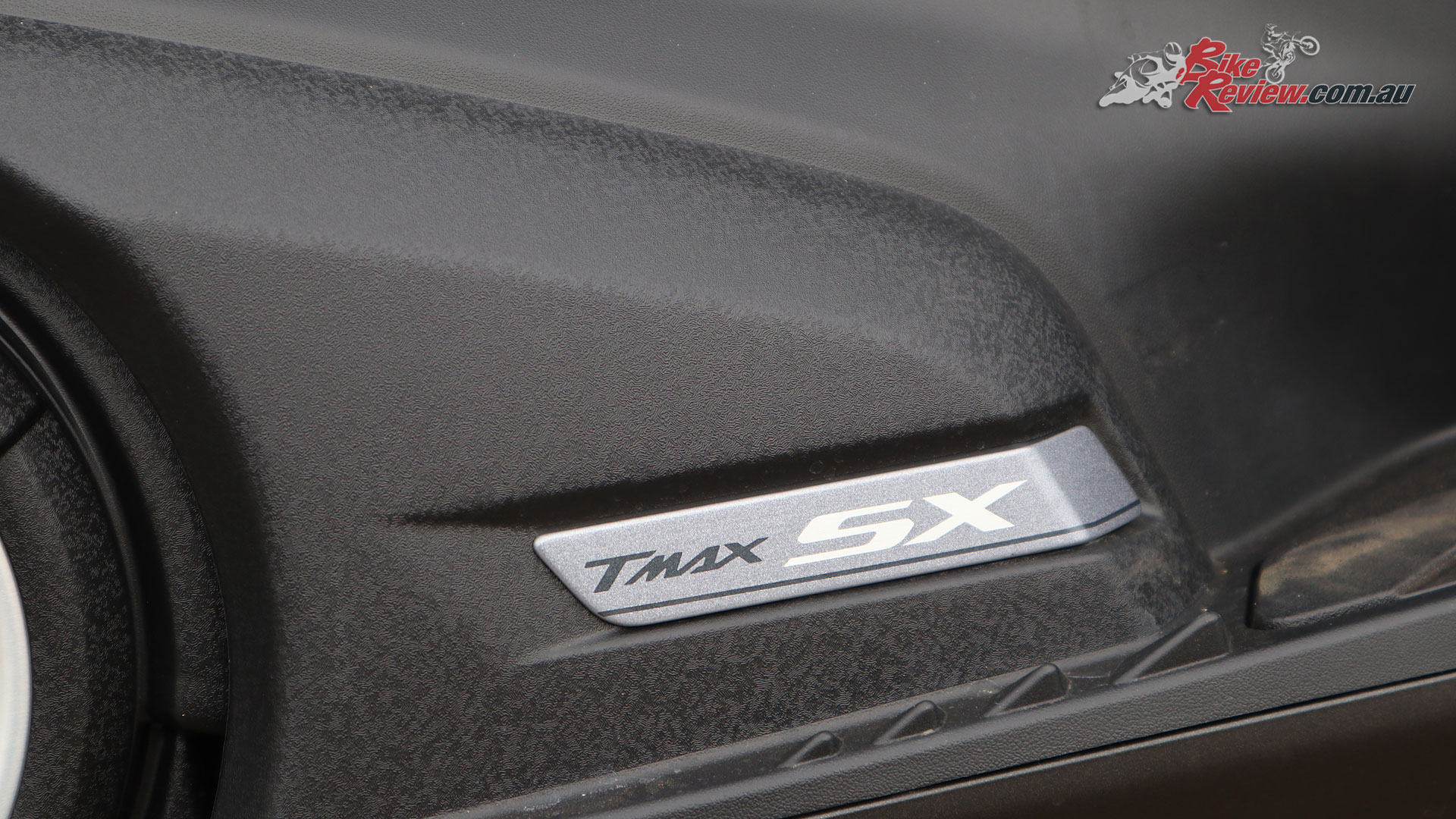
Yamaha have particularly gone out of their way to concentrate on the finer details, ensuring the TMax SX lives up to it’s premium (for a scooter) price-tag, and exceeds rider’s expectations
It might be the air-intakes by the headlights, or the slightly rounder lines, but I don’t find it quite as appealing. I don’t mind the looks on the SX, but I liked them on the Iron Max… The taillight and running lights are however cool, and the throw of light from the headlight is exceptional for nighttime riding, with highly visible indicators.
From an ergonomic perspective the SX is wide, particularly across the seat, with two footwell positions and a compact ‘bar assembly. The seat is comfortable, and offers enough storage underneath to store a full face helmet and a light jacket and gloves or two jet-type helmets according to Yamaha.
This is accessed via a console at the front of the seat, with the seat button and fuel button. Refueling also warrants a mention as I found it hard, with fuel spraying back up and cutting off fuel flow, even with the nozzle pushed through the plate, though fuel consumption seemed good at around the 20-25km/L mark. There’s also good wind protection from the screen, and exceptional wind/weather protection from the large front fairing.
The switchblocks are active with plenty going on, with the starter/on button on the right, as well as a mode button. You seem to need to be stopped to switch modes but with the very different power delivery between the two modes I can understand that.

There’s plenty going on, on both switchblocks, but you don’t need a user manual, it’s all easy to use.
The left switchblock holds your indicator and horn, with a dash toggle for the central LCD display and flasher. Traction Control isn’t multilevel or switchable, it’s just there, and the same can be said of the ABS. There is no cruise control on this model.
A central LCD is framed by a speedo and tachometer, and I would have liked to see speed across the LCD, as it’s truly easy to be cruising along much faster than is legal because of that super smooth power delivery. There’s also central locking which just makes sense on a scooter, have the fob in your pocket and walk up, hit the ‘On/Starter’ button and everything springs to life.
Get off the bike and hit ‘Off’ shuts and it all down, then turn the ‘bars to full left lock and hit Off(Lock) again and steering locks. The bike being off also locks the glove compartment, seat and fuel cap.

The TMax SX is definitely an open roader, but to pigeon-hole it into that role alone would be a mistake.
2018 Yamaha TMax 530 SX – The Ride
Overall the TMax SX is large, with a great low centre of gravity, very good stability and a comfortable seat. I did need to move around to get both feet flat to the ground at 180cm, on the leggy side, while putting my right foot down also made reaching the ground easier, where my left seemed to have a longer way to go.
Feet down in the usual scooter position feels natural around town, while getting your feet up into speed mode becomes natural at higher speeds, where you’re not starting and stopping constantly. The ‘bars to me are also an easy reach, with the screen offering good wind protection but also ending about eye level.
On the road that twin-cylinder is just obnoxiously good in S mode, there’s exceptional power, which is tamed by R6 supersport-style dual front brakes. A rear disc/caliper combo also offers good control for trail braking and around town, with a left ‘bar mounted handbrake for parking.
In S mode power is crisp, punchy and strong through most of the rev range, with a nice light throttle opening. T mode is more restrained, ideal for wet weather and offering more resistance at the throttle and what feels like more engine braking. It’s just not as free revving and is ideal for the wet, or if a new rider is picking up the TMax SX and wants slower power delivery as they practice their skills.
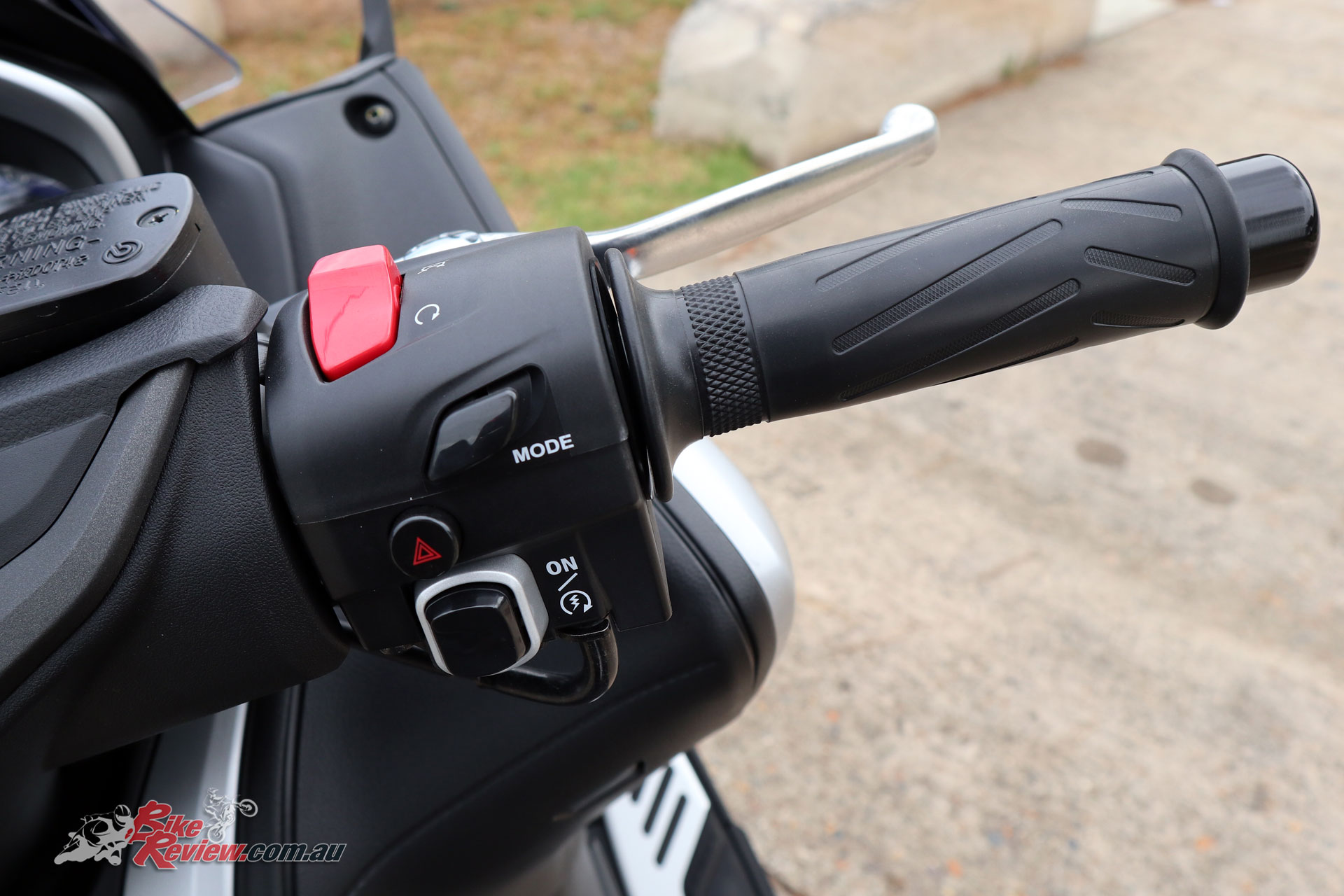
Modes are switchable on the right switchblock, and there is a significant difference between the two, which is great.
Steering is an interesting mix, the TMax SX is arguably a slow steerer, being so long, however those relatively narrow ‘bars give great control and it’s easy to see why they aren’t wider.
Take a more active approach to riding the SX, with a bit more aggressive lean and some ‘bar input turns the bike into a much sportier handler, which can turn quickly and easy and really carve up your local suburbs or twisties. The 15in wheels certainly serve to provide a more motorcycle-like ride, with Bridgestone rubber offering good performance, particularly in the dry.
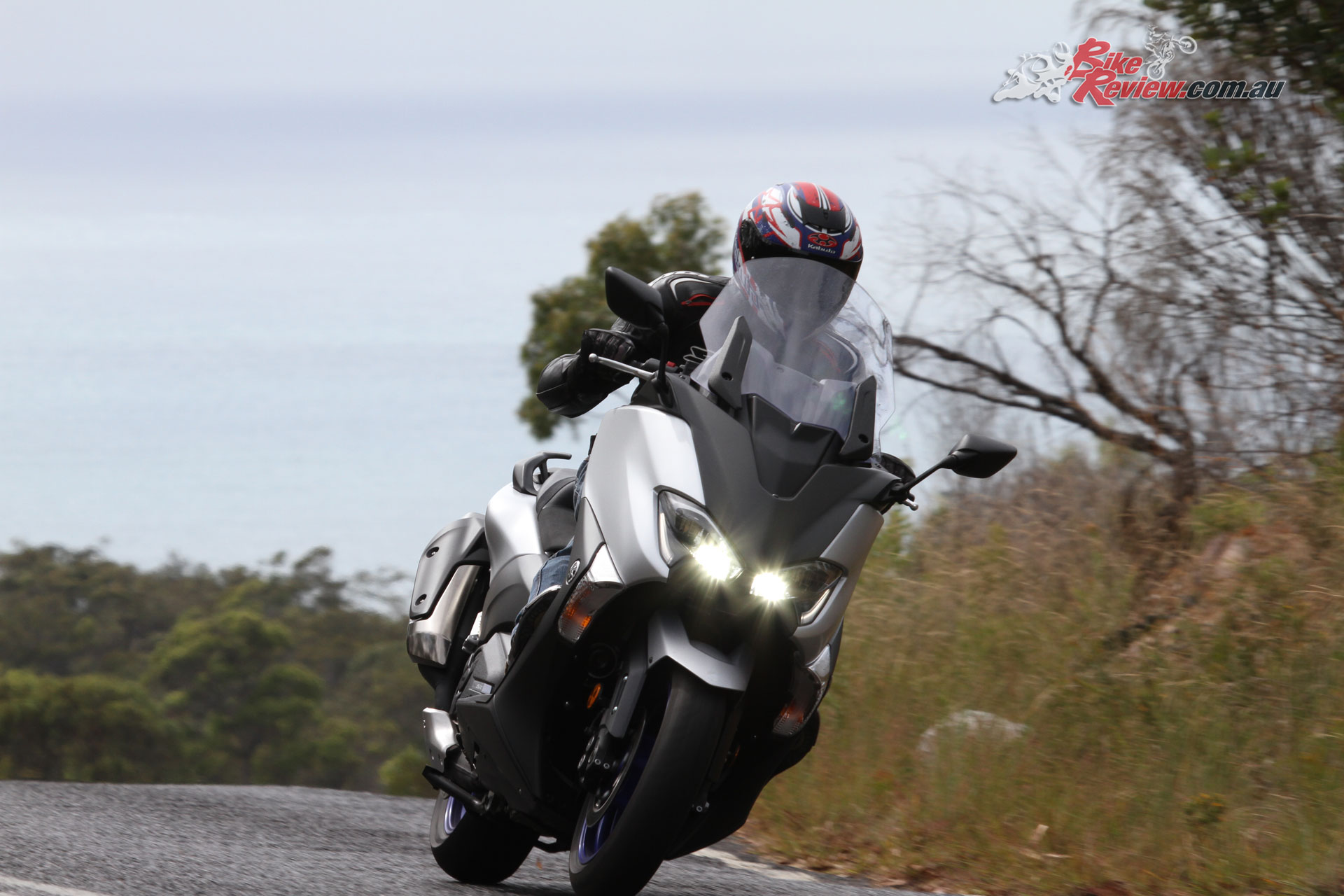
The TMax SX is exceptionally stable, even with heavy side-winds, and it’s easy to accidentally allow the speed to creep up on the open road without realising.
The super tight stuff will require heavy braking into the corners and really powering out, while more flowing sections can be taken at great pace, and ground clearance never seemed an issue during my testing.
Two-up the TMax SX also offers a great ride, with the suspension settling a little deeper and offering an easier reach to the ground, while the twin-cylinder powerplant is still easily capable of propelling you to illegal speeds in a rapid manner in S mode. In fact I’d say that the suspension is probably more suited to the two-up riding experience around town, where my usual 70kg riding weight is a bit too light.

Two-up is another strong point, with plentiful power, despite being LAMS, for two riders, with the suspension also ideally suited to this setup.
Of course the suspension is a strong mix of commuter and sportier capabilities, with a good mix of the two, that puts it in good company if you are after a fang, and it’s still well capable of being thrown around two-up. One point that did come up from my regular pillion was that the seat is exceptionally wide, meaning getting on can be a bit difficult if you refuse to step onto one pillion peg and swing across from there.
The other note was just how much torque the TMax SX had when it came to setting off from the lights and getting ahead of traffic, which was apparently pretty thrilling as a passenger, with the generous storage also getting the thumbs up.
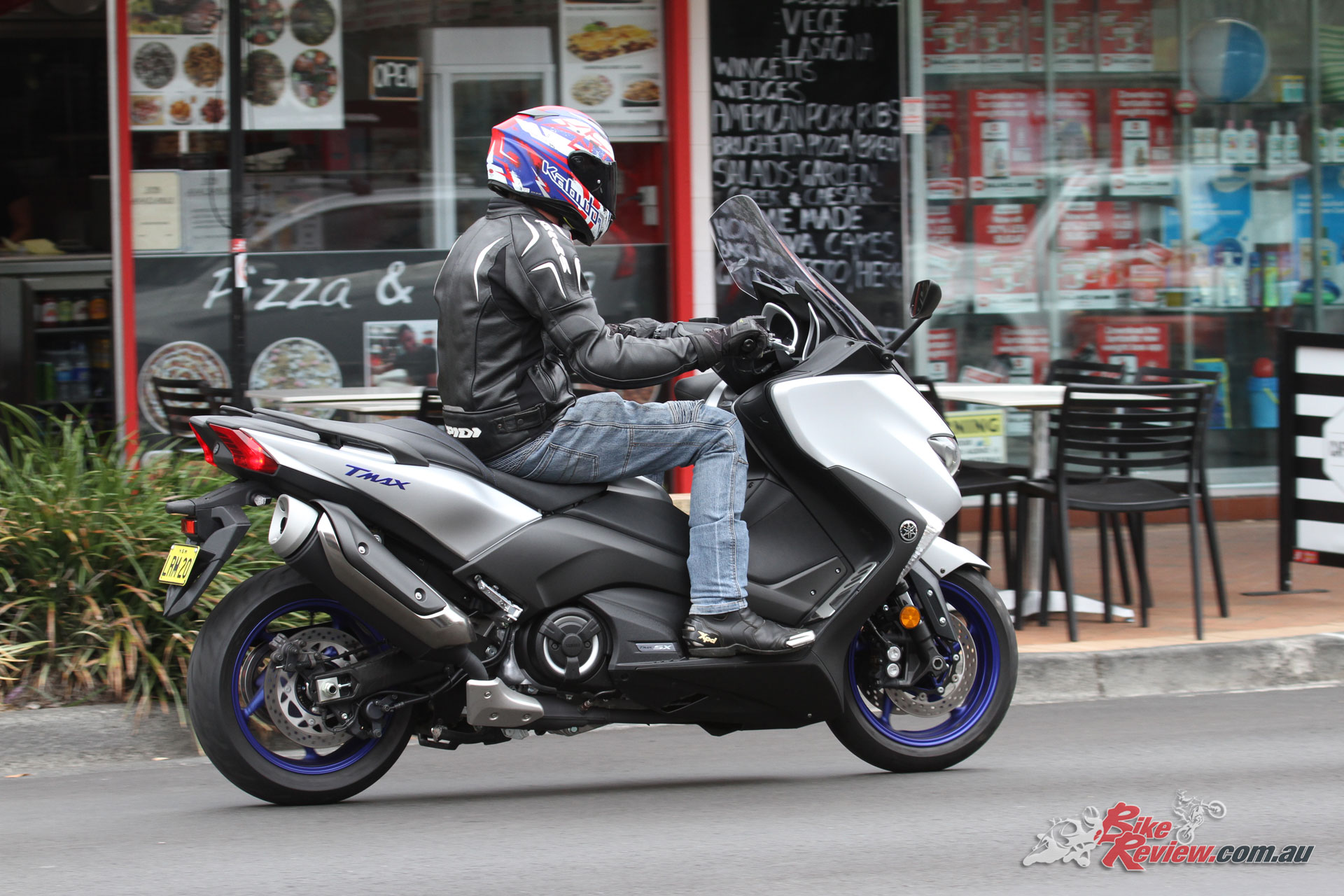
Even around town there’s enough torque to leave everyone in your dust when the lights go green, even other unsuspecting motorcyclists, and the TMax looks at home parked alongside motorcycles.
For me moving the scooter around, like reversing it on foot wasn’t too difficult either with the low centre of gravity meaning I could just brace against the console and walk the scooter back, however my pillion who rides a 250cc scooter found it heavy, when not using a similar technique, so if you’re worried about moving the TMax SX around, unless you’re considerably shorter than me at 180cm, it is possible (even easy) on relatively flat ground.
2018 Yamaha TMax 530 SX Conclusion
Overall the TMax 530 SX is a bit large and powerful for use purely as an easy inner-city commuter, with the width and size making lane splitting and parking more difficult. Like most larger bikes however, it’s definitely capable of these duties if needed, while it really comes into its own as a long distance commuter or as a touring-scooter.
Comfort is great, meaning longer trips away would be an easy sell to your significant other, and there’s more than enough power for practically anything you can think of.

With supersport brakes and high quality suspension the TMax SX is capable of giving plenty of machines a run for their money.
Plus being automatic it’s an easy, fuss free ride in traffic, and the comfort for larger framed riders is going to be a real benefit, alongside the spacious storage. In fact with my 150km commute a day up the Central Coast from Sydney it would be a great option for commuting, and can still generate the thrills through the twisties.
Obviously the TMax SX is a premium offering, but there’s a reason that Yamaha have sold over 200,000 TMax in 15 years, incorporating the same capabilities of many touring motorcycle options into a super user-friendly package. And being LAMS legal also means you could even induct younger family members into joining the fraternity.
So if you’re looking for a larger capacity scooter, or are happy to consider something a bit different, coming from the cruiser or touring segment (or just looking in their direction), definitely give the TMax SX a good look. For $14,499 RRP it may be on the pricier end of things for scooters, but it’s an absolute bargain compared to most tourers and cruisers.
Strengths
- Awesome power.
- Extremely smooth delivery.
- Power Modes.
- Traction Control.
- Supersport brakes.
- Low centre of gravity.
- LAMS legal.
- Good storage.
- Central locking/keyless fob.
Weaknesses
- Seat console placement/height.
- Wide, so reach to ground could be difficult for shorter riders, and filtering may be difficult.
- Filling with fuel is also a pain.
2018 Yamaha TMax 530 SX Tech Talk
For the full run-down on the TMax 530 you can check out the Tech Talk section on our Iron Max Test here. Here I’ll talk about the updates to the 2018 model to keep things succinct.
The 2018 TMax SX features a number of updates, including a new front fairing and headlight assembly including four LED headlights and position lights, as well as a new compact muffler.
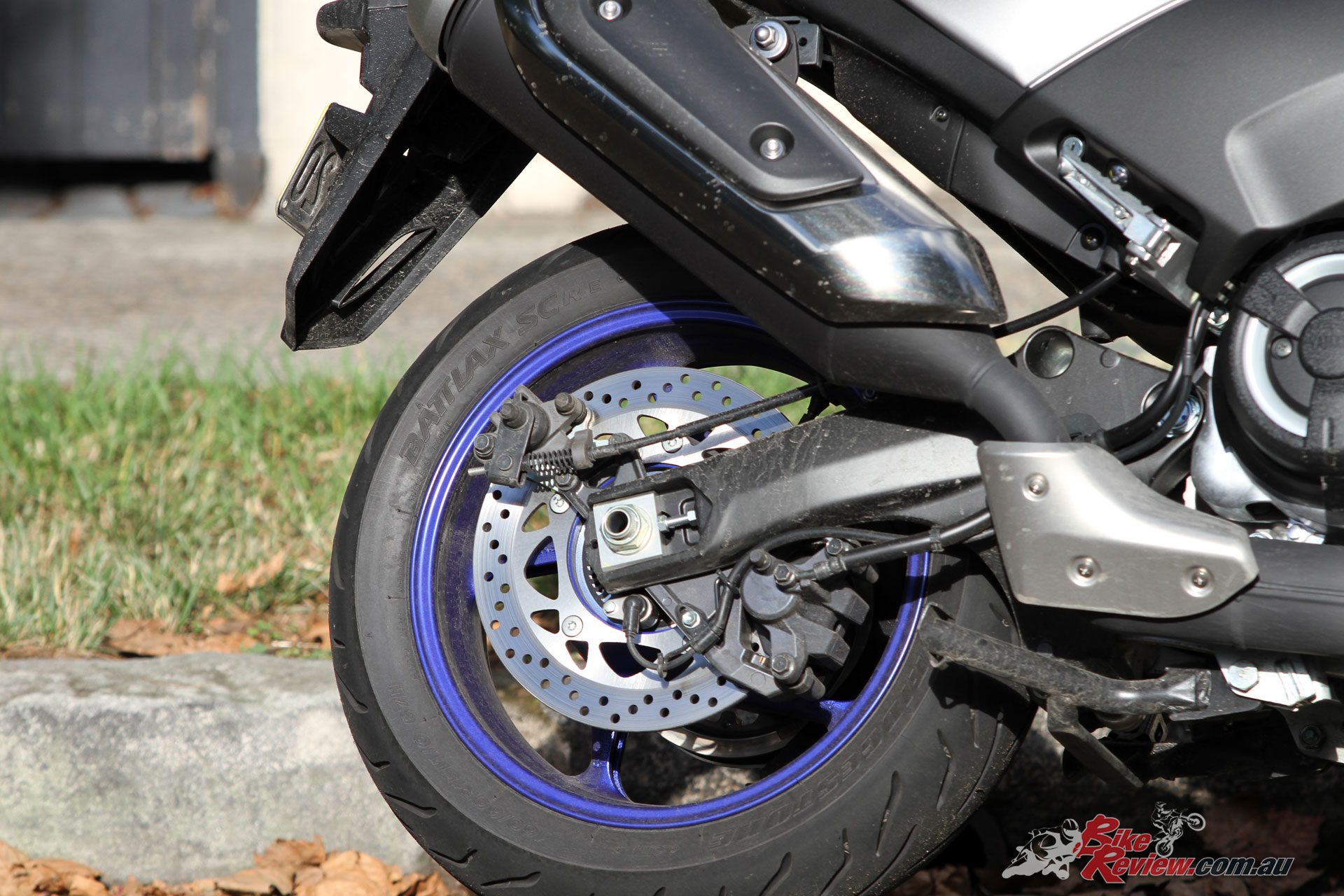
A new swingarm is featured, which is 40mm longer, while the overall wheelbase is 5mm shorter than the Iron Max.
9kg of weight has been shed with the adoption of a new lightweight die-cast aluminium frame, while the swingarm has been lengthened by 40mm, with the overall wheelbase 5mm shorter than on the Iron Max. Also new is a link-type rear suspension unit, with a horizontal shock absorber, with a progressive lever ratio to offer a strong mix of initial damping, and firmer performance at load.
A new drive trains is also used to help reduce unsprung weight, with lightened pulleys, and a thinner secondary belt of carbon-fibre. The rear wheel has also been reduced to 4.50in, despite using the same tyre, to help reduce weight further.
Underseat storage is also improved, offering room for two jet-type helmets, according to Yamaha, while a single full face easily fits with room for a light jacket and gloves.
New electronic systems include a Smart Key keyless system, with a fob that activates the bike when in proximity allowing it to be turned on. Central locking ensures the glove compartment cannot be opened with the bike locked, while access under the seat and to the fuel cap are via buttons in the console in front of the seat, also deactiveated with the bike off. Steering lock is switchable via the Off button.
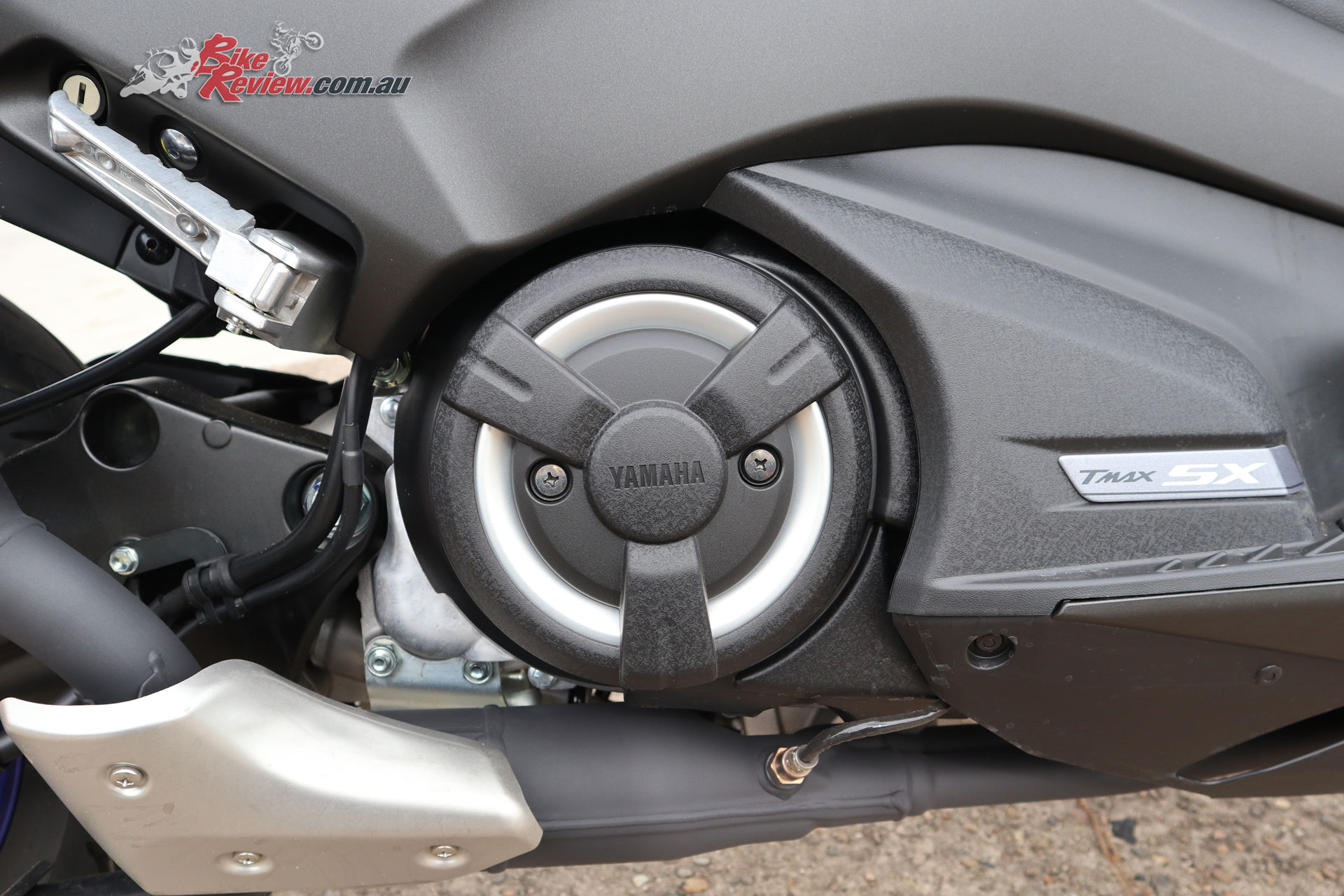
New electronics include a Traction Control System, with two ride modes on offer, and a Smart Key keyless locking system.
Big news is also the adoption of a Traction Control System (TCS), which works in conjunction with the Yamaha Chip Controlled Throttle (YCC-T), a first on a CVT model. Ride Modes or D-Modes can be switched via the right switchblock, with a sporty S Mode, and restricted T Mode, while the TCS is always on. ABS is standard fitment.
The dash is also updated with dual clocks and a central LCD display, with both a central and side-stand are standard. The TMax SX comes in two colour options – Matt Silver as tested, and Liquid Darkness.
The TMax SX is also D-AIR safety system ready.
2017 Yamaha TMax 530 SX (LAMS) Specifications
Price: $14,499 + ORC
Warranty: Two year, unlimited kilometre
Colour: Matt Silver (Tested), Liquid Darkness
Claimed power: 34.2kW[45.9hp]@6750rpm
Claimed torque: 52.3Nm[38.5ft-lbs]@5250rpm
Wet weight: 213kg
Fuel capacity: 15L
Engine: Liquid-cooled, parallel twin-cylinder, four-stroke, four-valve, 68 x 73mm bore x stroke, 530cc, 10.9:1 compression, EFI, TCI, Traction Control, D-Modes
Transmission: V-Belt, Automatic, CVT
Chassis: CF die-cast aluminium frame, aluminium swingarm
Seat height: 800mm, Wheelbase: 1575mm
Suspension: 41mm USD forks, 120mm travel, single shock absorber, 117mm travel
Brakes: ABS, Dual radial four-piston calipers, 267mm rotors, single rear caliper, 282mm rotor
Wheels & Tyres: Five-spoke alloy, 15 inch wheels, 120/70 – 15, 160/60 – 15
Instruments: Dual analogue clocks (speedometer/tachometer), central multifunction digital display
Storage: Underseat storage to fit a full face helmet with light that activates on opening, Glove box with cigarette lighter type power fitting

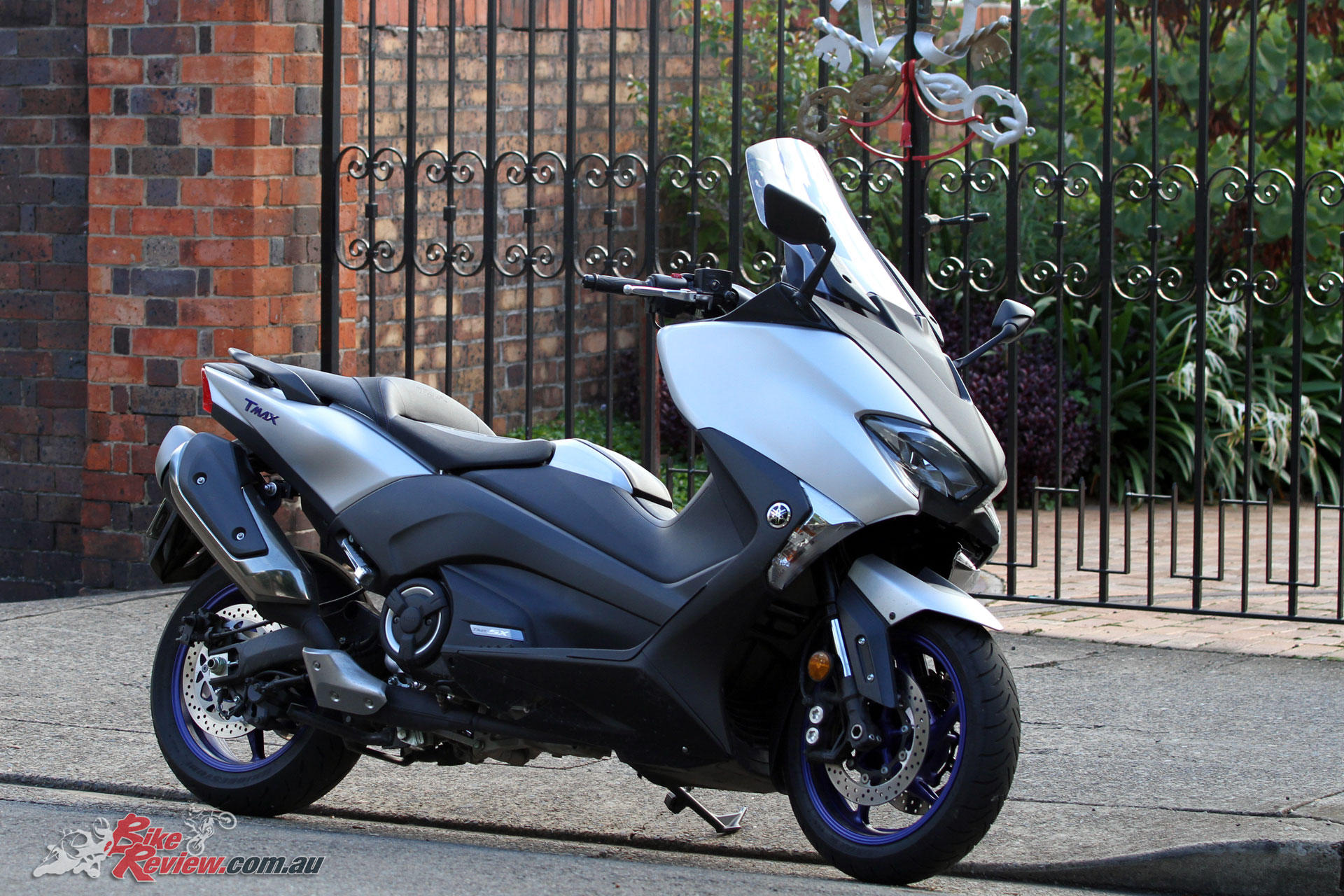
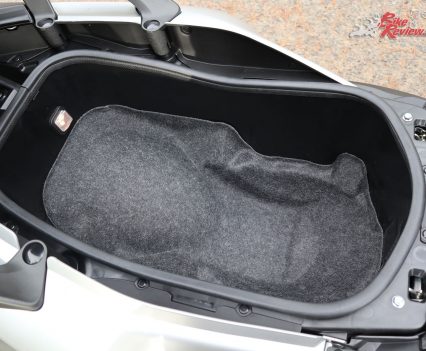
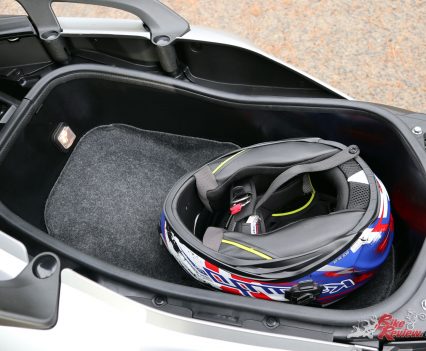
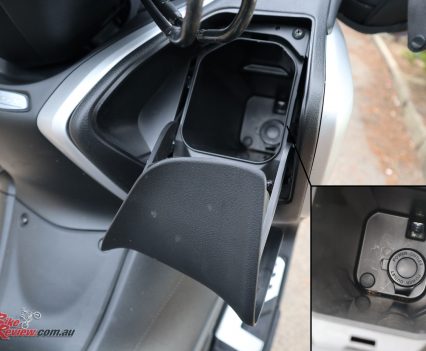
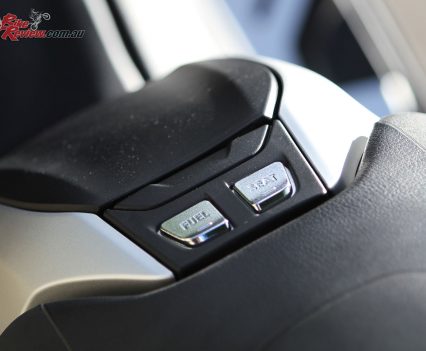









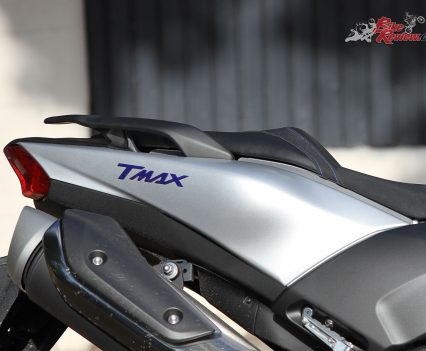
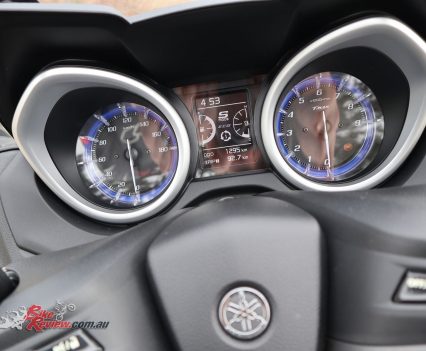

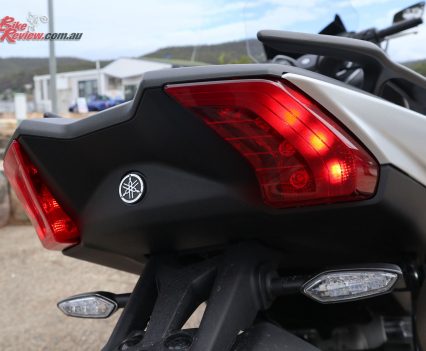
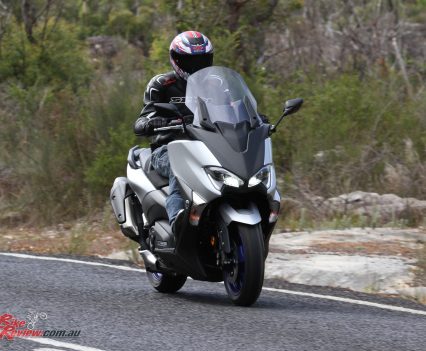


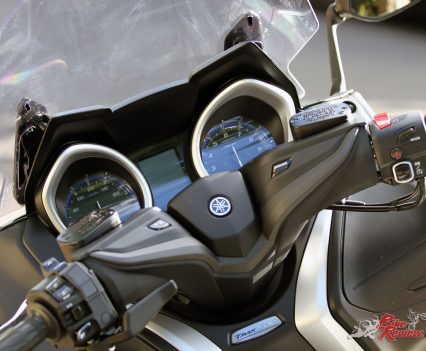

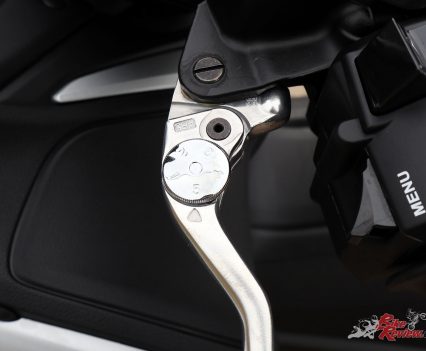


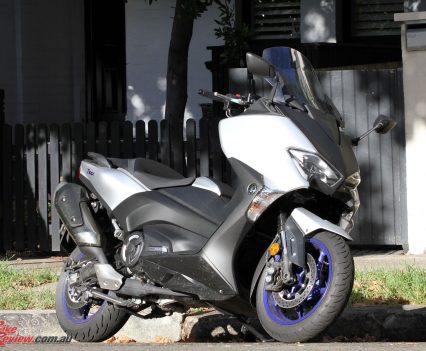
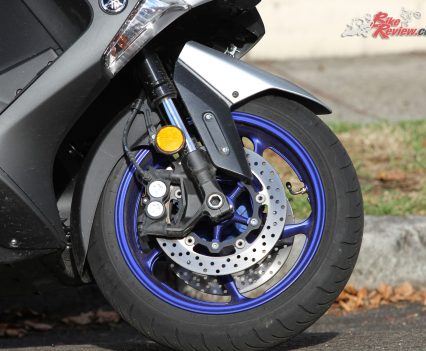


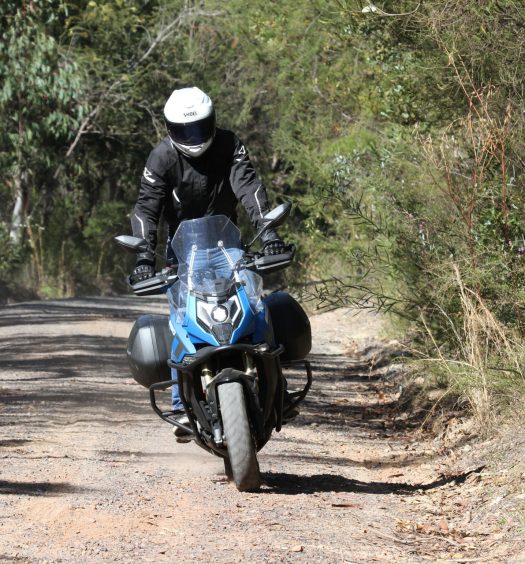
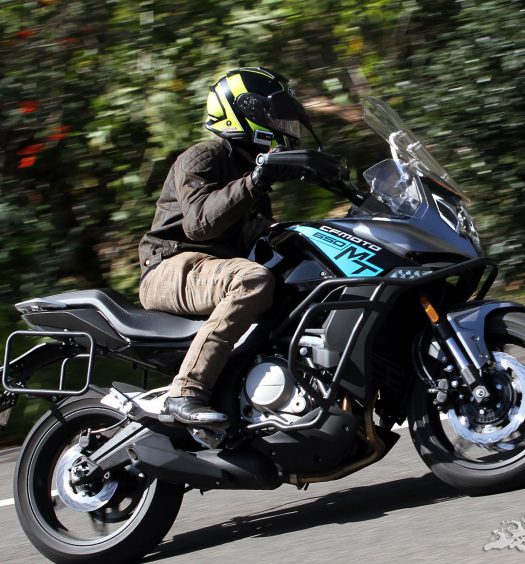





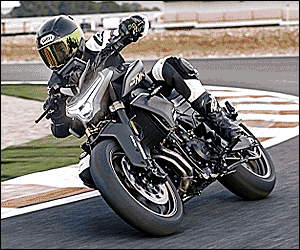
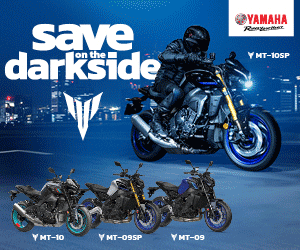







February 13, 2018
I owned a T-Max Iron which I was VERY impressed with especially the handling when the red mist descended! Mine was fitted with the optional Akropovic pipe so it sounded horn and it went like a rat up a drainpipe from the lights. Highway cruising was any speed you where willing to risk your licence at and it maxed out at better than a dollar sixty!
Although I currently ride a Triumph Explorer, the new model piques my interest however the deletion of cruise control when there appears provision for one in the LH switch cube leave me asking, why not Yamaha?
Perhaps Yamaha Australia deleted this feature to control pricing?
February 13, 2018
Hey David,
With the 2018 models they seem to have offered the DX and the SX, with the two offering a few distinct features. We got the SX here in Australia, while the DX comes standard with cruise control and a few other perks. If I had to guess I’d say the DX would have carried a heftier price tag, and with scooter sales on the rough side, they may have chosen to just bring in the SX. It’s a shame it’s not available as an accessory, but with the TMax being such a huge seller overseas they probably bring both models into most markets, so it may not have been a concern. Conversely only putting the cruise control on the more expensive/higher spec version overseas would make it an easier upsell.
February 18, 2018
I have owned a Tmax500 for 7 years next to my Honda CB1300 and 9 out of 10 I took the Yamaha because it’s just so good. It’s an amazing bike. Shame there is no market for it in Australia (back then took 6 months to sell with a massive loss) that’s why I bought a XSR900. You can’t even test ride one because all Yamaha dealers stay away from it and not stock them. I would still love to own this new one with a standard cruise control and a $5000 price cut.
August 3, 2018
I feel my TMax 530 needs more power on touring rides. I wish they will make his engine more powerful like 650 or maybe 700cc. While riding long rides he is lucks of power.
October 27, 2018
Hi Kris.
Is the sx Tmax model available now Australia-Wide? or only in N.S.W?
Thank’s
Boaz.
October 29, 2018
Hey Boaz, I would assume the whole of Australia, but I’ll double check that for you just to be sure!
November 20, 2018
I have just completed an overhaul of a second-hand 2014 Tmax 530 with <10,000kms on the clock, adding Malossi variator and lighter weights, Matris suspension front and rear, LED lighting all round, dashcam front and rear, GPS, LED driving lights, new brake pads and front disks, Givi top case, custom backrest, some bling to match the new metallic blue paint job and gold wheels, and all for thousands less than a new one. I love the beast, now christened Blue Max. I would add photos, only I can't.
November 20, 2018
Nice stuff Wayne! That sounds awesome. You can use the Contact Us form to shoot us an email, if you’d like to send some pics in!
September 8, 2019
I just bought a T Max in NZ ($16,500 + ORC !) but I love it; loads of power for the overtake, huge comfort for the long fang, and reasonable fuel consumption…looks nice too!
September 13, 2019
Far out, man that is a few $$$ over there but agreed the TMax is an amazing scooter and absolutely hammers. Any plans for modifications?
Jeff.
February 15, 2020
Just purchased a Tmax sx and have to say i love it and so proud to finally own one after 12 months of looking at it and falling in love with.cant wait too doing some long distance rides.
Has anyone done much long distance on there’s and how far is this bike capable of doing? Can anyone assist me with some further information on this question ?